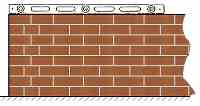HOME EXTENSION.com
SUCCESSFULLY EXTENDING YOUR HOME
Checking brickwork
There are 4 steps that bricklayers use to check their brickwork as it is being built:-
-
Gauge – checking the height of each course
When building any wall, it’s essential the courses at each corner are at the same height. A simple gauge board ‘ruler’ can be used to check.

This is a strip of straight timber roughly 2 m long with the heights of each brick (or block) course marked on it, including the thickness of each mortar joint, normally 75mm (65mm + 10mm).
Hold it up against each corner to check that the courses are at matching heights. On uneven ground, a datum peg next to the wall can act as a level base.
2.
Level – making sure the courses are level
A bricklayer’s spirit level is used to keep the courses level.

Because it is the corner bricks that have been set to the correct height, any adjustment should be made by bedding down the bricks working inwards from the corner.
Bricks are not always manufactured to exact tolerances, so don’t waste time trying to get each individual brick perfectly level.
Place the spirit level on top of a row of freshly laid bricks and aim to get the bubble in the spirit level at dead centre.
Don’t worry about trying to get the bricks precisely level widthways.
-
Plumb – making sure that the wall is vertical
The spirit level is now used to check that the wall face is vertical.
To make any adjustments, bricks should be gently tapped across the wall as necessary.
But don’t try and do this on both sides of the wall – choose one side as ‘the face’ and stick to getting that side plumb. Repeat this at regular points all along the wall, about every metre or so.
At the corners, be sure to check both sides.
-
Straight – making sure the wall is straight
To check that the courses are straight, run a horizontal line along them, or hold a straight edged piece of timber (or large spirit level) between the points you’ve just plumbed.

Adjust the bricks by tapping them into place as necessary.
As before, stick to one face of the wall, don’t try to straighten both sides.
If you’re using irregular shaped bricks, it is unlikely that your straight edge guide will touch each uneven brick surface across its whole face.
So aim to get the centre of each brick to touch the straight edge guide.
















